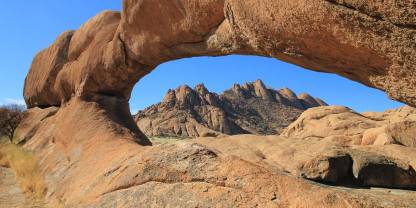Average Expert Rating
Rating Breakdown
Write a User ReviewDesert Elephants and Rhino
Read more
wilderness and elephant lovers; however, if you’re primarily after the charismatic cats then I would probably give it a miss.On the Rocks
Read more
chorus of barking geckos, I enjoyed that special brand of wilderness isolation that Namibia has made all its own. What’s more, I did it all in my own humble Toyota Corolla.The Desert Elephants of Damaraland
Just south of Kaokoland, Damaraland is equally barren and a must for those who like to get off the beaten path and experience remote Namibia in all its glory. The undulating, rugged semi-desert landscapes are striking and always make me feel strangely melancholic, and the flora and fauna, though not always abundant, are fascinating.
In particular, Damaraland is known for its black rhinos and desert-dwelling elephants, though both can be hard to find. I’ll never forget the experience of tracking rhino on foot, even though we didn’t actually see any in the end – the sense of total wilderness and the big skies were enough. Seeing elephants in this environment, or any other wildlife for that matter, is equally unforgettable, in part because it seems so unexpected that anything can survive here.
Damaraland also has some of the best eco lodges and camps to be found in Namibia, and fascinating archeological sites like Spitzkoppe, both of which help make the overall safari experience about much more than just wildlife.
Desert-Adapted Elephants and Rhinos
One of the absolute wildlife highlights of Namibia is the rocky and predictably arid region known as Damaraland, home to one of the world’s few populations of desert-adapted elephant, as well as desert-adapted black rhino. My first sighting of a herd of elephants marching through this unpromising terrain, below dramatic black cliffs, will stay with me forever, as will the rather bizarre sight of their tentative attempt at crossing one of the reserve’s normally dry watercourses after a rare flash flood. Aside from elephant and rhino, there isn’t much variety of wildlife on offer here, but the wilderness atmosphere more than compensates.
Big Skies, Beautiful Landscapes, and Big Game
Water is as rare as one would expect in this desert environment, and elephants here are known to dig wells with their tusks to reach the water table below. They then stretch their trunks down into the holes and slurp up any moisture within reach.
It was a beautiful scene in a region where beautiful scenes are commonly seen.
Damaraland is home to all sorts of desert-adapted wildlife. There are black rhinos who get all the liquid sustenance they need from eating poisonous succulent plants. There are oryx who, I am told, can go their entire lives without ever having experienced a gulp of water. Some plants survive years without rain, and perhaps even more surprisingly, some people live here too.
The
Read more
Himba people, with their beautiful ochre-painted skins and intricate clay-infused hairstyles, somehow manage to eke out a traditional lifestyle in a barren but serene environment that would kill less-hardy folk.Whilst Damaraland isn’t as resplendent in wild game sightings as, say, Etosha National Park, the endless landscapes of fantastic geological formations, rocky plains, and golden grasslands, make for a captivating experience.
Spitzkop and Brandberg look as if they have been transported straight out of America’s Monument Valley.
There are plenty of rustic wilderness campsites for the self-drive crowd and a good selection of top-end lodges for those who prefer their wilderness served with a slice of comfort, coddling, and air conditioning.
The nighttime skies are phenomenal, as are the sunsets, which turn the mountains and plains into glowing hues of ochre and amber.
Amazing Rock Formations & Desert-Adapted Elephants
Among the first things that come to mind when I think of Damaraland are its rock formations – deep-red and ochre massifs, streaked with black, rising steeply up from the parched ground and rimmed by the twisted leaves of ancient welwitschia plants. Desert-adapted elephants roam this starkly beautiful and seemingly barren terrain, as do black rhino and desert-adapted lion – both only spotted with great luck – as well as an abundance of lizards, snakes, scorpions and other small desert creatures. In addition to its striking landscapes and unusual wildlife, Damaraland is also known for its rock art. Twyfelfontein has one of the largest collections of rock engravings anywhere in Africa, and nearby Brandberg (Burnt Mountain) also contains an impressive collection. Allow enough time to explore the rock engravings. They are often relegated to a relatively short detour, but proper exploration can easily take the better part of a day. Damaraland’s convenient location between Etosha National Park and the Skeleton Coast makes the area well suited for longer combination itineraries.
Damaraland: Wild Beauty
I’d also rank Damaraland as one of Namibia’s most beautiful corners, an astonishingly beautiful land of red sand, great, bouldered mountains that take on weird and wonderful
Read more
forms, and picturesque dry watercourses that run from the mountains down to the coast. Put them all together and Damaraland surely offers one of the most dramatic backdrops for any safari anywhere on the continent. And don’t let the absence of a national park deter you – this is one of the most exciting safari destinations in the region.Where Black Rhinos Roam
Damaraland also has beautiful semi-desert landscapes: richly coloured slopes and plains dotted with weathered rocks and drought-resistant plants. One of the most unusual is the scraggly-looking welwitschia. A surprising variety of wildlife species survive these harsh conditions, too. Desert-adapted elephants patrol the dry river

